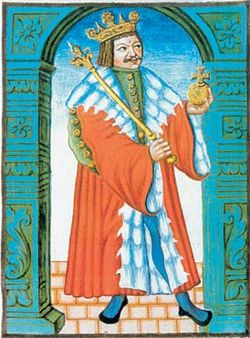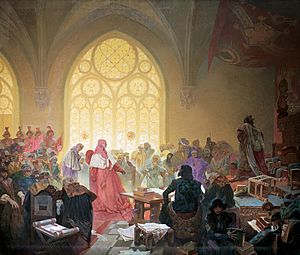George of Poděbrady facts for kids
Quick facts for kids George of Poděbrady |
|
|---|---|

Jiří of Poděbrady depicted in a codex from 1607
|
|
| King of Bohemia | |
| Reign | 2 March 1458 – 22 March 1471 |
| Coronation | 2 March 1458, Prague |
| Predecessor | Ladislaus I Posthumous |
| Successor | Vladislaus II |
| Born | 23 April 1420 Probably at Poděbrady Castle |
| Died | 22 March 1471 (aged 50) Prague |
| Spouse | Kunigunde of Sternberg Johana of Rožmitál |
| House | Poděbrady |
| Father | Victor of Munsterberg |
| Mother | Anna of Wartenberg |
| Religion | Utraquist Hussite |
George of Kunštát and Poděbrady (born April 23, 1420 – died March 22, 1471) was an important King of Bohemia. He ruled from 1458 to 1471. George was a leader of the Hussites, a Christian movement in Bohemia. He was known for being fair and open-minded towards Catholic people.
His time as king was special because he worked hard to keep peace. He wanted Hussites and Catholics to live together peacefully in Bohemia. Because of this, people called him "King of two peoples" and "Friend of peace." Later, he became known as a great diplomat and a brave leader. He is also remembered for his idea of creating a group of Christian countries in Europe. This idea is now seen as an early vision of the European Union.
Contents
Early Life and Rise to Power
George was the son of Victor of Kunštát and Poděbrady. His father was a Bohemian nobleman and a leader of the Hussites. George's mother is not known by name.
When he was 14, George fought in the Battle of Lipany in 1434. This battle ended the more extreme parts of the Hussite movement. By this time, George's father had passed away in 1427, so George was an orphan.
George quickly became a strong leader among the Hussites. He defeated the troops of King Albert II of Habsburg. Albert II had become King of Bohemia after King Sigismund. After Albert's death, his son Ladislaus became king. Bohemia was then split into two groups: those loyal to the Catholic Church and the Hussites, led by George.
In 1448, George led his army into Prague, the capital city. He took control almost without a fight. A civil war began, but George managed to defeat the nobles who supported the Catholic Church. In 1451, Emperor Frederick III made George the administrator of Bohemia. This was confirmed by a meeting of nobles in Prague.
Becoming King of Bohemia

The fight between the Hussites and the Pope's supporters continued. King Ladislaus, who was crowned in 1453, favored the Catholic Church. This made George's position difficult. In 1457, King Ladislaus died suddenly. Some people thought George had poisoned him. However, later research in 1985 showed that Ladislaus died from acute leukemia.
On March 2, 1458, the nobles of Bohemia chose George as their king. Even some Catholic nobles voted for him. They respected his fair policies. Also, many people wanted a Bohemian ruler, not a foreign one.
King George tried to rule fairly, following an agreement called the Compacta of Prague. He gained the support of some Catholics. But he faced strong opposition from Pope Pius II. The Pope declared the Compacta agreement invalid in 1462. He wanted George to agree to this, but George refused. George tried to please the Pope by punishing some extreme Hussites.
A Vision for Peace in Europe
George had a truly groundbreaking idea to bring peace with Rome. He suggested a treaty among all Christian powers in Europe. This included countries like Hungary, Poland, Bohemia, France, and Italian states. More countries would join later.
The main idea was that all member states would promise to solve their disagreements peacefully. There would be a common parliament and other shared groups. George presented this idea as a way to stop the "abominable Turk" (the Ottoman Empire). The Ottomans had captured Constantinople in 1453.
He sent his brother-in-law, Jaroslav Lev of Rožmitál, to visit European courts. Jaroslav carried a draft of this "message of peace" treaty. George hoped the treaty would start in 1464. This plan is now seen as one of the first ideas for European unity, much like the European Union today.
However, the plan did not happen. George's efforts to make peace with Rome failed. Pope Pius II's plan for a crusade against Bohemia also did not happen. After Pius died in 1464, George tried to talk with the new pope, Paul II. But Paul II was also a strong opponent.
Challenges and a New King
George made enemies among the Catholic nobles. In 1465, they formed an alliance against him. Pope Paul II supported this alliance. On December 23, 1466, the Pope removed George from his position as King of Bohemia. This meant that all Bohemian subjects were freed from their promises to George.
Emperor Frederick III and Hungarian King Matthias Corvinus joined the rebellious Bohemian nobles. This started the Bohemian War. Matthias conquered a large part of Moravia. He was crowned king of Bohemia by the Pope's supporters in Olomouc in 1469.
George fought successfully against Matthias. But, against the wishes of his own supporters, he made an agreement with the Hungarian king in 1470. George's followers then chose Vladislaus II, the son of the Polish king, as his successor. This was to continue the fight against Matthias.
Legacy
Many places in the Czech Republic are named after King George. The large Jiřího z Poděbrad Square in Prague 3 and its nearby metro station are examples. Other squares named after him are in Ostrava, Hořice, and Poděbrady.
In 1896, a statue of King George on horseback was put up in Poděbrady. It was made by the sculptor Bohuslav Schnirch. During World War I, a military unit called the 2nd Czechoslovak Rifle Regiment was named after King George.
Marriages and Children
In 1440, George married Kunigunde of Sternberg. They had six children:
- Boček (1442–1496)
- Victor (1443–1500), who became a prince and duke.
- Barbara (1446–1469)
- Henry the Elder (1448–1498)
- Katharina (1449–1464), who was a twin. She married Matthias Corvinus of Hungary but died young.
- Sidonie (1449–1510), Katharina's twin.
After Kunigunde died in 1449, George married Johana of Rožmitál in 1450. They had four children:
- Henry the Younger (1452–1492)
- Frederick (1453–1458)
- Agnes (believed to have married in Wallachia)
- Ludmila (1456–1503)
See also
 In Spanish: Jorge de Podiebrad para niños
In Spanish: Jorge de Podiebrad para niños
- Gregory of Heimburg

